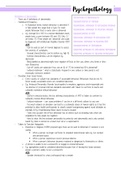Features of model (Markets allocate resources in a Pareto effiecient way)
• Households maximize utility
• Firms maximize profits
• Prices adjust to clear markets
Pareto efficiency
-markets work well in such model
-First welfare theorem: allocation Pareto efficient ⇒ no market failures
Fiscal stimulus
• Government spending often considered tool to fight recessions
• Idea:
Recession associated with marketfailure
Government spending helps to counteract this market failure
Why useful to consider model without market failures
1 Markets may work well most of the time
Policy makers may want to know what increasing spending does when markets work well
2 Provides benchmark for looking at empirical evidence:
• Model may be consistent with empirical evidence
• If we see discrepancies: nature of discrepancies may give us indication what market failures to
introduce
Main insights from model in this chapter
1.Government spending reduces resources of private sector
More spending ⇒ higher taxes ⇒ less resources for households
two reasons:
1. Total output F(Nt)= Ct + Gt
Thus G ↑ → crowding out C → C↓ due to the wealth effect
2. If government likes to spend more, T ↑→ C↓
2.Households
1 Consume things they buy
2 Time spent not working for pay
lower income ⇒ household reduces both
• More spending reduces resources available to private sector ⇒ private consumption
drops & employment increases
• Output increases less than the increase in government spending
• Income ↑→ C↑→ l↓
Microfounded Models
Two-part specification:
Physical environment
1 The set of commodities which are produced and consumed
2 The set of households, and the preferences of each household over commodities
3 The technologies available to transform commodities into other commodities
4 The initial endowment of the economy with commodities
, Role
• Describe what is physically possible
• Says nothing about how allocation of resources is decided
Resource allocation mechanisms
Possibilities
• Central planner
• Of primary interest for us: combination markets & government
Market economy
• GE theory: firms & households take prices as given
• Decisions decentralized, made by households & firms • Assume optimization: households
utility, firms profits • Need to specify ownership of endowments
Advantages of Microfounded Models
1 Better chance to predict effects of policy change well
2 Can examine effects of of policy change on utility of households, can even try to determine
optimal policy
Modeling of behavior using microeconomic theory
• Model objectives & constraints
• Assume households & firms do best they can (optimization)
Lucas critique
• Firms/households may change behavior when policy changes
• This may invalidate behavioral rules inferred from past behavior
Sterke correlatie tussen inflatie en outputfluctuaties die gemeten wordt wanneer men een
Phillips-curve schat. Verschil interpretatie correlatie. In het Lucas-model veroorzaakt een (niet-
geanticipeerde) verandering in het algemene prijsniveau een trendafwijking van de output, in de
Phillips-curve veroorzaakt een trendafwijking van de output een prijsverandering.
Het Lucas-model toont dat onverwachte monetaire schokken de output in de korte termijn
kunnen beïnvloeden.
Keynesianen verwerpen de idee dat prijzen en lonen flexibel genoeg zijn om de markten
onmiddellijk te ruimen, zij veronderstellen daarentegen dat nominale prijzen en lonen zich traag
aanpassen.
Simple Lucas critique example: Fort Knox
Model based on past behavior
• Fort Knox has never been robbed
• May specify model in which criminals do not rob Fort Knox
Contemplated policy change
• Remove security to save money
• Good idea based on model of past behavior
Microfounded model
• May predict: criminals don’t rob Fort Knox if & only if it has security • Eliminating security bad
idea
• Lucas critique: must be circumspect with policy predictions











